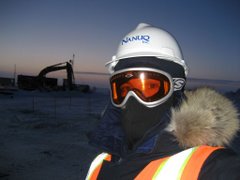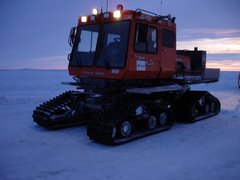
A few of you have asked exactly what in the hell I'm doing up here in the middle of Winter. Aside from freezing my horses patoot off I'm helping to build a series of ice roads in the Alpine oil field.
Ice roads are built every Winter season in this section of the North Slope field (as well as in many others) to allow for resupply of the drilling facilities with materials that are too expensive to or not possible to fly in. We are also building a larger separate ice road to facilitate gravel mining, hauling, and placement operations for expansion of one of the satellite drill pads. Every permanent facility in the oil field is built on a gravel pad and every permanent road is constructed from gravel. It's actually considered a wiser practice from a health and safety standpoint to build a separate ice road for a major gravel haul to keep haul traffic away from smaller truck traffic.
The method of construction for an ice road is essentially similar to the way in which an asphalt road is built. Conventional roads are built by cutting in the road alignment, placing a base course, and then laying down an asphalt emulsion. For an ice road you start by "walking in" the initial alignment (the alignment by the way is set by some crazy surveyor on a snowmobile dragging a sled with gear and survey stakes) with a large rubber tired water truck called a "water buffalo." As you pack the snow down with the tires you spray out water from the back end of the truck to freeze the snow in place (i.e. your base course). I should mention here that the idea is to do zero damage to the tundra during the initial and all following stages of road construction. Before this was practice materials used to be dragged across the tundra by bulldozers pulling steel sleds... cat tracks from up to 30 years ago can still be seen scarring the tundra today. To that effect the AK DNR doesn't allow tundra travel each year until sufficient snow has fallen (~6") and the top layer of the tundra has frozen (-5 deg C at -1 meter for ~ 5 days). If/when damage to the tundra occurs it's reported to DNR so they can go back to that location after the Summer breakup to see if the damage was permanent.
Instead of an asphalt emulsion we lay down ice chips and water to build the remaining layers of the road to achieve the minimum 6" thickness. The chips are ground off of the surface of adjacent lakes and rivers with a large roto-tiller and loaded in to 30 cy end dumps (aka Maxi Hauls). The Maxis take the chips to a section of road where they are needed and dump them out over an area that has just been watered. Next, a road grader blades out the chips and then that section is flooded with more water. When the temperature is optimal at about -20F this new section will freeze in a matter of minutes. When a large enough section has been completed the grader comes in to give the road a final shave and then that section is capped with another flood; usually from a large 325 BBL tanker. The water we use is pumped from arctic lakes that have a permitted allowable volume to be used each year.
In other cases we have to construct an ice road over a naturally frozen lake or river. In this case a "pumper" is used to ground the ice prior to chip placement. A pumper is essentially a medium sized New Holland tractor with a custom mechanism on the back... one part stainless steel auger and another part submersible pump housing. The real trick is that by pumping water from beneath the ice you don't actually see the build up on the surface. As you place water on top of the existing ice it freezes and becomes additional surface ice that due to it's weight sinks the existing ice beneath it. When the ice sinks far enough to touch the river or lake bottom then it's considered grounded and you can begin placing chips and water to build the road to an elevation higher than the natural ice surface. This is sometimes considered an "ice bridge" with a design thickness of up to 11 feet required to carry ~ 500,000 lb. loads (i.e drill rig or camp module sections). The idea here is that grounded ice is safer than floating ice. Road safety is also enforced not only through design and construction methods but by controlling speed... they use security personnel with radar guns... imagine getting a ticket for speeding in the Arctic! There has been cases though of heavy trucks moving fast enough over an ice bridge to create a frontal pressure wave. When this wave reaches shore it breaks open the ice and results in a sunken truck and a driver under threat of death from exposure if help isn't close at hand.
The weather up here is no joke. Typical temperatures have been -30 to -50 F with winds averaging around 15 to 20 mph daily. Under these conditions exposed skin will become frostbitten in less than five minutes. I usually walk from camp to the trailer that I work out of but it's a less than ten minute walk and the gear that keeps me warm is arctic grade and very expensive... worth every penny though... fill face mask and ski goggles are the norm and my favorite part of the gear... perhaps because it reminds me of diving :)







No comments:
Post a Comment